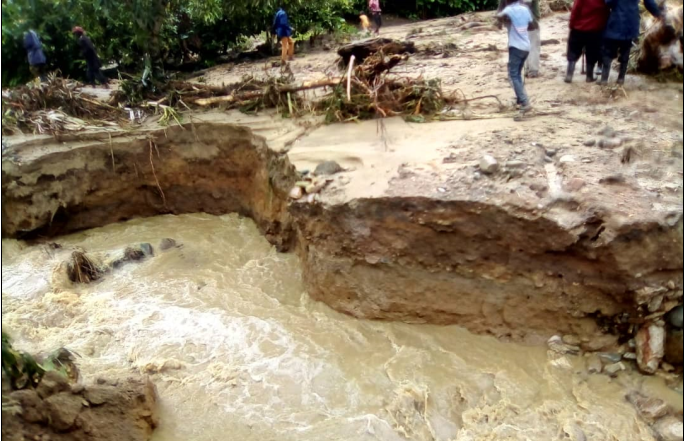Kasese, Bundibugyo victims return to flood-prone areas

Residents look on after floods destroy property in Rukoki Sub-county, Kasese District in 2022. PHOTO/JOEL KAGUTA
What you need to know:
- Uganda Red Cross Society installed early warning systems to disseminate information to communities along River Nyamwamba in case of floods.
Flood victims in Kasese and Bundibugyo districts have returned to the flood-prone areas, accusing the government of failure to resettle them.
The affected people, who are living in camps, said they have been experiencing torrential rains since last month.
The worst floods happened in September last year, where 16 people died after landslides hit Kasika Trading Centre. Rivers burst their banks, leaving hundreds of people displaced.
President Museveni in June 2021 while in Kasese pledged to resettle all flood victims and asked district leaders to look for alternative land for their resettlement in vain.
Since 2020, some victims are camped in Muhokya Transit Camp while others are living Kasika Anglican Church of Uganda.
Those, who were unable to handle the conditions at the camp, returned to their areas that included Kanyangeya, Kasika Trading Centre, Karusandara, Kitholu, Kilembe, Bulembia, and Kyondo.
Ms Kezia Biira, a resident of Kirindi Village, Harugale Sub-county in Bundibugyo, said his house was submerged in 2019 and she has been staying in makeshift houses.
“Whenever it rains, we keep awake in anticipation of a disaster,” Ms Biira said.
Mr Geoffrey Kiiza Bonny, a resident, who eked out a living through growing cocoa and bananas, said his plantations were washed away.
He has now resorted to stone quarrying in the river streams. In Kasese, crops were destroyed after a downpour last Thursday.
Rivers Kanyabuku and Rwabihungu, both originating from Rwenzori Mountain burst their banks.
Mr George Masereka, a resident of Kanyangeya Cell in Nyamwamba Division, said he returned to his land after realising the government promise wasn’t forthcoming.
“We are living in dire conditions,” he said.
The Kasese District Senior Environmental Officer, Mr Augustine Kooli, said the district disaster management committee has been strengthened through establishing a technical advisory committee on disaster risk reduction to support practical and technical skills.
“We have already come up with an evacuation plan and it starts with community mobilisation by ensuring that the community understands that disasters can happen anytime,” Mr Kooli said.
Plans to buy land for displaced victims
The Kasese Chief Administrative Officer, Mr Elias Byamungu, refuted claims that government had already released money to buy land for the displaced persons.
He said people, who wanted to sell 400 acres of land to the district, were members of Maktib mixed farmers but their land has disputes and more than 240 households.
Mr Byamungu said the issue of land ownership must be settled if government is to buy the land.
“I have told the government that if they are to buy the proposed land found in Bwenanule cell in Muhokya Town Council, they shouldn’t evict those claimants who said have lived on the said land for more than 60 years,” he said.
Measures taken
Uganda Red Cross Society installed early warning systems to disseminate information to communities along River Nyamwamba in case of floods. Radios have been set up in Kilembe, Mubuku and Karusandara to alert people to vacate.
In June last year, government secured Shs17 billion from the World Bank to desilt 5.4 kilometres of River Nyamwamba and works are expected to be complete this year.
The Ambitious Construction Company has since last year been working in areas of Masule, Kyanjuki, Kyanjuki camp, Namuhuga and Kyonjojo, where they have maintained the earth work, building gabion masonry and dyke.
Dr Emmanuel Brian Guma from Ministry of Water and Environment, said with a funding of Shs13 billion from World Bank in 2021, they started implementing a number of catchment measures on River Nyamwamba such as river bank stabilisation, re-afforestation, desilting, coffee value chain, and stone craft development.
The project coordinator for NRDI, Mr Kipura Zalot, said they have done soil and water conservation activities on 421 hectares of land involving building of trenches, water basins and planting trees on 520 hectares.
By Joel Kaguta, Longino Muhindo, Alex Ashaba & Moureen Biira




